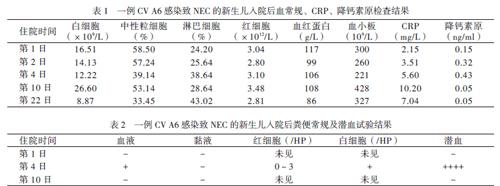柯萨奇病毒A6感染致足月新生儿NEC、肠穿孔一例
2020-08-29林瀚妮李管明张霭润翁立坚房晓祎
林瀚妮?李管明?张霭润?翁立坚?房晓祎


【摘要】新生儿肠道病毒感染以隐匿感染为主,症状不典型,但可发生严重并发症,甚至导致死亡,可引起新生儿病房暴发性感染。该文报道1例因感染柯萨奇病毒(CV)A6导致坏死性小肠结肠炎、肠穿孔、感染性休克的新生儿。患儿为女性,因皮肤黄染及排血便而入院,结合临床表现及完善相关检查后考虑为坏死性小肠结肠炎、败血症。经予积极综合治疗后,包括禁食、胃肠减压、扩容、抗感染、输注血液制品等,患儿于住院第28 日痊愈并出院。患儿出院后大便逆转录PCR结果回报:住院第2日、第23日大便 CV A6均阳性,遂补充诊断为新生儿CV感染。新生儿败血症需重视肠道病毒感染可能,及时进行病原学检测十分重要。
【关键词】肠道病毒;柯萨奇病毒;新生儿;感染性休克;肠穿孔;坏死性小肠结肠炎
Necrotizing enterocolitis and intestinal perforation in a term infant caused by Coxsackievirus A6: a case report Lin Hanni, Li Guanming, Zhang Airun, Weng Lijian, Fang Xiaoyi. Department of Neonatology, the Seventh Affiliated Hospital of Sun Yat-sen University, Shenzhen 518107, China
Corresponding author, Fang Xiaoyi, E-mail: judyfangxy@ 126. com
【Abstract】Neonatal enterovirus (EV) is mainly manifested with occult infection and atypical symptoms. However, it may cause severe complications, and even death. It can also lead to the outbreak of nosocomial infection in the neonatal ward. In this article, one female case of neonatal necrotizing enterocolitis, intestinal perforation and septic shock caused by Coxsackievirus (CV) A6 infection was reported. She was admitted to hospital due to yellow skin and bloody stool. The possibility of necrotizing enterocolitis and septicemia was considered according to clinical manifestations combined with relevant examinations. After active and comprehensive treatment including fasting, gastrointestinal decompression, volume expansion, anti-infection, and infusion of blood products, the neonate was cured and discharged. At the 2nd and 23rd d after hospitalization, RT-PCR revealed the stool samples were positive for CV A6. Hence, she was diagnosed with neonatal CV infection. The possibility of EV infection should be considered for neonatal septicemia. It is of significance to deliver detection of the pathogen.
【Key words】Enterovirus;Coxsackievirus;Newborn;Septic shock;Intestinal perforation;
Necrotizing enterocolitis
腸道病毒(EV)是单股正链RNA病毒,属于微小RNA病毒科,是婴幼儿感染常见病毒[1]。EV型别众多,包括:①人脊髓灰质炎病毒1 ~ 3型;②人柯萨奇病毒(CV),A组(CVA)1 ~ 22型和24型,CV A23型为埃可病毒9型,CV A6可引起手足口病,B组(CVB)1 ~ 6型;③致肠细胞病变人孤儿病毒(ECHO),即埃可病毒1 ~ 9、11 ~ 21、24 ~ 27、29 ~ 33共29个血清型,E22型、23型分别是副肠孤病毒1型和2型;④新型EV 68 ~ 72型,其中1971年分出的EV D70型可引起急性出血性结膜炎,EV A71型可引起手足口病,EV A72型为甲型肝炎病毒[2]。新生儿可通过胎盘、产道或生后获得性感染EV,并可因母亲、医护人员或新生儿间交叉感染在新生儿病房引起EV暴发流行[3]。新生儿感染多由CV和ECHO引起,虽然大多数患儿出现的是非典型或轻微的临床症状,但也有发生危及生命的感染可能而导致预后不良[4-5]。在本文中,笔者报道1例因感染CV A6而引发坏死性小肠结肠炎(NEC)的新生儿病例,以引起临床医师对新生儿EV感染的重视,加强管理。
病例资料
一、主诉及病史
臨床上可通过血、粪便、尿液等病毒分离方法明确EV感染的诊断,但耗时较长、不实用,目前多采用RT-PCR方法检测病毒血清型,较为快速、准确。
新生儿EV感染无特殊治疗,主要是对症及支持治疗。本例经过抗休克、禁食、胃肠减压、抗生素及维持内环境稳定等保守治疗后症状逐渐好转,2周后重新喂养、停抗生素,胃肠功能恢复,全身表现良好,最终获得痊愈。有文献报道大剂量丙种Ig能提供特异性抗体,可以改善严重EV感染的预后,但缺乏科学证据支持[14]。有临床试验证实EV衣壳抑制剂Pocapavir、Pleconaril能较快清除病毒、降低病死率,但无法逆转已发生的器官损伤,对严重EV感染效果不佳[15-16]。
综上所述,新生儿EV感染可致严重并发症,临床医师必须高度重视。在临床工作中,我们必须密切观察新生儿病情变化,做到早预防、早识别和早处理,避免发生严重并发症。
参 考 文 献
[1] Wallace SS, Lopez MA, Caviness AC. Impact of enterovirus testing on resource use in febrile young infants: a systematic review. Hosp Pediatr, 2017, 7(2):96-102.
[2] King AMQ, Adams MJ, Carstens, Lefkowitz EJ. Virus taxon-omy: classification and nomenclature of viruses: ninth report of the international committee on taxonomy of viruses. San Diego: Elsevier, 2012: 931-934.
[3] 郭玥馨. 新生儿肠道病毒感染的高危因素分析. 临床研究, 2017,25(1): 194-195.
[4] Centers for Disease Control and Prevention (CDC). Nonpolio enterovirus and human parechovirus surveillance——United States, 2006-2008. MMWR Morb Mortal Wkly Rep, 2010, 59(48): 1577-1580.
[5] Chuang YY, Huang YC. Enteroviral infection in neonates. J Microbiol Immunol Infect, 2019 , 52(6):851-857.
[6] Lagae D, Rigo V, Senterre JM, Kalenga M, Piérart J. Early enterovirus neonatal infection: when should we think about it? Rev Med Liege, 2016 , 71(2):78-82.
[7] Harik N, DeBiasi RL. Neonatal nonpolio enterovirus and parechovirus infections. Semin Perinatol, 2018, 42(3):191-197.
[8] 林瀚妮, 房晓祎, 李管明, 张霭润, 李宁宁, 林霓阳. 新生儿重症监护病房住院新生儿粪便肠道病毒类型及感染临床特点. 中华妇幼临床医学杂志(电子版),2019, 15(6):681-687.
[9] Berger JR, Chumley W, Pittman T, Given C, Nuovo G. Persis-tent coxsackie b encephalitis: report of a case and review of the literature. J Neurovirol, 2006, 12(6): 511-516.
[10] Dunn J. Enteroviruses and Parechoviruses. Microbiol Spectr, 2016, 4(3): 1-22.
[11] Morriss FH Jr, Lindower JB, Bartlett HL, Atkins DL, Kim JO,Klein JM,Ford BA. Neonatal enterovirus infection: case series of clinical sepsis and positive cerebrospinal fluid polymerase chain reaction test with myocarditis and cerebral white matter injury complications. AJP Rep, 2016, 6(3): e344-e351.
[12] Jones G, Muriello M, Patel A, Logan L. Enteroviral meningo-encephalitis complicated by central diabetes insipidus in a neonate: a case report and review of the literature. J Pediat Inf Dis Soc, 2015, 4(2): 155-158.
[13] Amdani SM, Kim HS, Orvedahl A, John AO, Said A, Simpson K. Successful treatment of fulminant neonatal entero-viral myocarditis in monochorionic diamniotic twins with cardiopulmonary support, intravenous immunoglobulin and pocapavir. BMJ Case Rep,2018,2018:bcr2017224133.
[14] Ooi MH, Wong SC, Lewthwaite P, Cardosa MJ, Solomon T. Clinical features, diagnosis, and management of enterovirus 71. Lancet Neurol, 2010, 9(11): 1097-1105.
[15] Collett MS, Hincks JR, Benschop K, Duizer E, van der Avoort H, Rhoden E, Liu HM, Oberste MS, McKinlay MA, Hartford M. Antiviral activity of Pocapavir in a randomized, blinded, placebo-controlled human oral poliovirus vaccine challenge model. J Infect Dis, 2017, 215(3): 335-343.
[16] Abzug MJ, Michaels MG, Wald E, Jacobs RF, Romero JR, Sánchez PJ, Wilson G, Krogstad P, Storch GA, Lawrence R, Shelton M,Palmer A, Robinson J, Dennehy P, Sood SK, Cloud G, Jester P, Acosta EP, Whitley R, Kimberlin D, the National Institute of Allergy and Infectious Diseases Collaborative Antiviral Study Group. A randomized, double-blind, placebo-controlled trial of Pleconaril for the treatment of neonates with enterovirus sepsis. J Pediatric Infect Dis Soc, 2016, 5(1): 53-62.
(收稿日期:2020-02-22)
(本文編辑:洪悦民)
